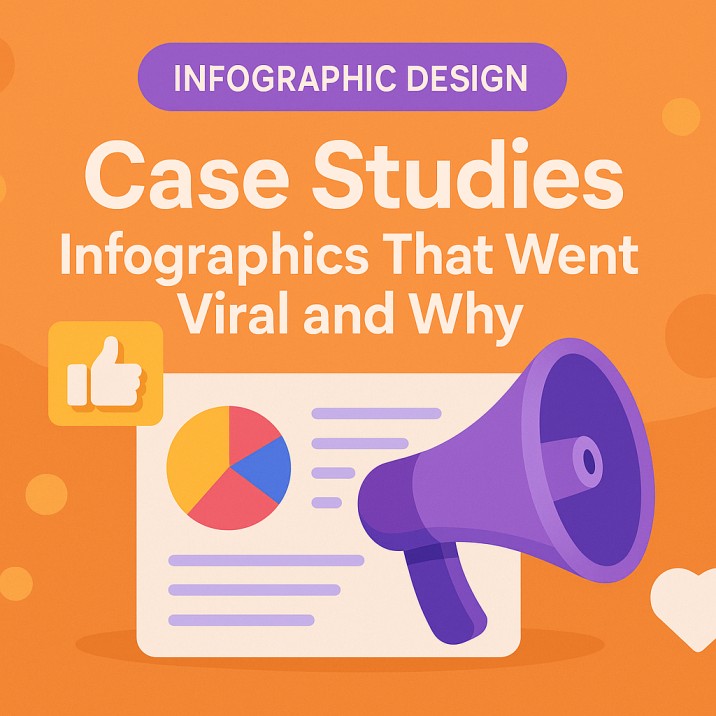In the age of short attention spans and endless scrolling, visuals are your brand’s best friend. For instance, among all forms of visual content, infographics hold a special place—especially when exploring viral infographics case studies. In fact, they simplify complex ideas, turn stats into stories, and are highly shareable across platforms. Moreover, research shows that infographics are shared three times more than other types of content on social media. So, what makes an infographic go viral? Let’s break it down.
What Makes an Infographic Go Viral: Viral Infographics Case Studies?
Going viral isn’t just luck— rather, it’s strategy. While there’s no magic formula, most viral infographics share a few common ingredients. For example, visually striking design grabs attention. Additionally, strong storytelling makes data relatable. Also, timely topics fuel sharing. Furthermore, platform-specific formatting ensures the content spreads far and wide.
So, here’s what typically contributes to infographic virality:
- Visually striking design that grabs attention.
- Strong storytelling that makes data relatable.
- Timeliness – addressing trending or urgent topics.
- Platform optimization – designed for sharing on social, blogs, or news sites.
- Emotional appeal or surprise factor that sparks conversation.
Now, let’s explore some viral infographics and unpack what made them stand out.
Case Study 1: “What Happens One Hour After Drinking a Can of Coke?”
When a health blogger published this infographic, they aimed to simplify and visualize the science behind soda consumption. The piece broke down what happens inside the body after drinking a single can of Coca-Cola—hour by hour.
The vertical layout was ideal for scrolling, especially on mobile and platforms like Pinterest. Moreover, bright, bold icons were paired with color-coded timestamps that guided readers through each phase—from the sugar rush to the caffeine crash.
After gaining initial traction on health forums, the infographic went viral when it was picked up by major publishers like HuffPost and Business Insider. It struck a nerve by focusing on a universally relatable topic—our love-hate relationship with sugary drinks—while using a clean, simple design to communicate shocking health facts. Thus, that mix of familiarity and surprise made it irresistible to share.
Case Study 2: “How Music Affects the Brain”
This infographic explored how different types of music stimulate various parts of the brain. For instance, it used a brain illustration at its core, surrounded by colorful visualizations that showed which musical elements triggered which cognitive responses.
The infographic masterfully balanced technical neuroscience data with everyday experiences—like how classical music helps with concentration or upbeat music boosts motivation. As a result, it offered a learning moment wrapped in emotional resonance, which is a key factor in virality (as noted in studies on viral content).
Social media platforms like Reddit and Tumblr helped it go viral, and it was also widely used in classrooms and on educational sites like Edutopia. Its success stemmed from its dual appeal—it entertained while it educated. Additionally, its vibrant yet tidy design made it easy to absorb and perfect for sharing.
Case Study 3: “The Daily Routines of Famous Creative People”
Everyone is curious about the habits of successful people. This infographic capitalized on that curiosity by visually mapping out the daily routines of famous creatives like Beethoven, Maya Angelou, and Elon Musk.
The timelines were laid out in color-coded horizontal bands, making comparisons easy and fun. For example, readers could instantly spot patterns—who woke up early, who prioritized exercise, and how much time they spent on deep work.
It was featured on platforms like Lifehacker, Brain Pickings, and LinkedIn, and became a hit among productivity fans and creative professionals. Its design clarity combined with aspirational content helped it achieve widespread reach. It didn’t just inform—it inspired.
Key Takeaways from Viral Infographics Case Studies
Across all three case studies, a few common themes emerge:
- Relevance is key: Topics that relate to daily life—like health, productivity, and emotions—perform best.
- Data needs storytelling: Infographics that guide the viewer through a logical, emotional journey stick better.
- Design simplicity wins: Clean visuals with intuitive layouts outperform complex, cluttered graphics.
- Optimized for sharing: Mobile-friendly formats, especially vertical layouts, help boost reach.
Additionally, insights from recent trends suggest that credible data and proper sourcing—like citing government reports or studies—enhance trust and shareability. For instance, adding a sources section at the bottom of your infographic can boost credibility, as noted in guides on creating viral infographics in 2025.
Why Infographics Matter for Your Brand
Infographics are more than just eye candy. When done right, they:
- Boost brand visibility through shares and backlinks.
- Improve engagement across social platforms and blogs.
- Build thought leadership by distilling your expertise into digestible content.
- Improve SEO through keyword-rich titles, filenames, and alt text.
Therefore, in a content-saturated world, infographics offer your brand a shortcut to attention.
Best Practices to Make Your Infographics Go Viral
Want to create an infographic that stands out? Here are some tried-and-true design tips:
- Stick to one big idea: Don’t overwhelm your audience.
- Use verified data: Accuracy builds trust.
- Design for scanning: Use headings, icons, and white space to help users skim.
- Start with a hook: A surprising stat or fact can reel readers in.
- Format for mobile and social: Think vertical layouts and small file sizes.
- Brand it subtly: Include your logo or website without overwhelming the design.
Make Your Brand Stand Out Visually
Infographics aren’t just pretty pictures—they’re strategic storytelling tools that cut through the noise. By combining visual design, smart data, and audience insight, your brand can create content that informs, inspires, and gets shared far and wide.
At Fuel IT Online, we help you turn your brands’ complex ideas into engaging, high-performance visuals. Whether you want to educate, inspire, or convert, our creative team is ready to bring your next viral infographic to life. Get in touch and let’s make your content unforgettable.




